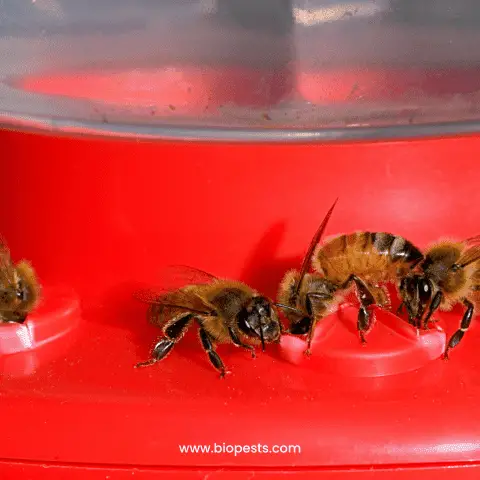Hummingbirds are lovely and fascinating creatures. They can hover in the air and have a heartbeat rate reaching up to 1200 beats per minute. It’s no wonder many people want to attract them to their backyard. My love for these birds started last year when I found an abandoned hanging nest hidden in the bushes of my garden. I observed how these delicate little birds came and fed from my flowers in the following months.
However, with the bad season approaching, I decided to “help them out” and buy them a feeder so they won’t run out of food. I didn’t know that installing a hummingbird feeder can also invite ants, bees, wasps, and other small critters. For that reason alone, deciding where to hang your feeder is very important.
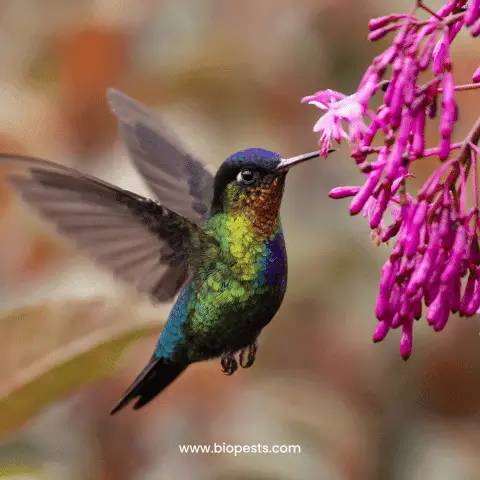
Whether you have already made the investment or are considering it for the first time, I will discuss here the best practices for hanging your hummingbird feeder and how to keep other birds and pests from partaking.
Where Should You Hang Your Hummingbirds Feeder?
The first thing to consider when attracting hummingbirds is where to hang your feeder. The secret to success is all about location! Here are a few tips on where to place the bird’s feeder:
- In A Visible Place: Preferably, you’ll want to pick a spot that gives you the best view of your feathered friends in action. It would be a shame to place the feeder in a hidden place where we can’t enjoy the view, right? Be careful, however, not to place it too close to your windows! We don’t want any accidental collisions interrupting your bird-watching bliss.
- In A Protected Shaded Area: The best location to hang your feeder is near flowers or shaded areas. Keep in mind that hummingbirds love the sun, but they also love the shade, so it’s essential to find the right balance.
- In A Spacious Area: make sure it’s in a spot where they can easily flutter about. Give them space to spread their wings so they can zip back and forth without awkward collisions. And while you’re at it, see if you can find a nice perch nearby where they can rest and take in the view.
- In An Accessible area: Find a spot to easily reach your feeder and ensure it’s in good condition. Keep that feeder clean so those little flappers keep coming back for more. Last but not least, remember to fill your hummingbirds’ feeders with fresh nectar every few days. They’ll thank you for it!
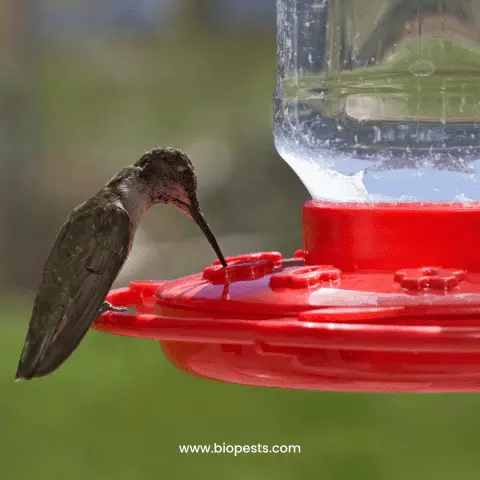
How Many Hummingbirds Feeders Should You Get?
One hummingbird’s feeder is like having one cookie – it’s just not enough! You may want to consider setting up multiple hummingbird feeders in different locations around your garden so that the birds don’t become overly dependent on one particular spot. This way, if one area becomes overrun with pests or predators, they’ll move onto another feeding station without an issue.
Furthermore, regularly check and clean the area where you’ve placed the feeders, as this will help ensure that only hummingbirds visit your station and not any other unwanted visitors.
How To Stop Other Pests From Feeding From The Hummingbirds Feeder?
Hummingbirds are such delicate creatures that add beauty and joy to any outdoor space. But did you know that their feeders also attract some uninvited guests? Yup, those sweet nectar-filled feeders are like a beacon to a whole host of pests that you might not be aware of. From sneaky ants and bees to pesky wasps and squirrels, many creatures can’t resist the allure of the hummingbird’s feast.
Let’s look closer at who’s crashing the party and learn how to keep these critters at bay!
Ants: Have you ever heard of an ant moat? It’s not a fancy castle but it protects your hummingbird feeder from unwanted guests. You see, ants love the sugar water in the feeder just as much as the hummingbirds. But with an ant moat, you create an obstacle the ants can’t cross, and at the same time, add a visual decor to the feeder (check this beautiful one from Amazon). The ant moat acts as a barrier by simply filling a small chamber with water, preventing the tiny invaders from accessing the sweet nectar.
It is also possible to purchase a feeder with a built-in ant moat, like this one.
Bees: Bees looove the sugary water that is in the feeder. If you wish to stop bees from swarming around the feeder, make sure to:
- Place the hummingbird feeder away from areas of heavy flower growth or other shrubs where bees may be attracted.
- Move the feeder to a spot where it won’t be in direct sunlight for more than an hour daily. Choose a shaded location or away from flowering plants, as bees are naturally drawn to those areas.
- Set up a bee guard around the hummingbird feeder by placing a simple netting or screen over it.
- Use a sugar-water solution to attract bees away from the hummingbird feeder instead.
- Make sure to keep your hummingbird feeders clean and free of food residue to avoid attracting bees.
- Do not purchase yellow feeders (always choose the color red – hummingbirds’ favorite!), as bees are attracted to this color.
- Consider using bee traps near your home if all else fails.
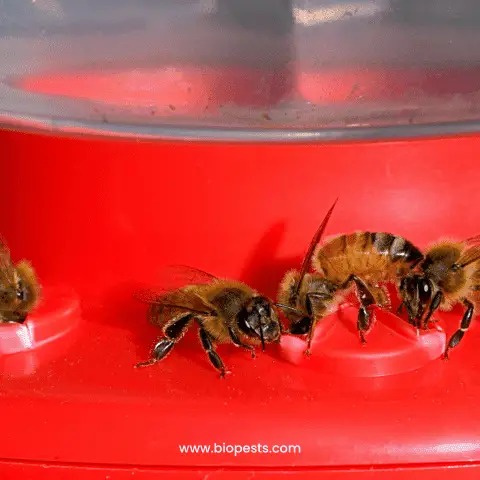
Wasps: Wasps are unwanted guests that will gather around the feeder. To prevent this pesky pest from visiting your yard, try placing a wasp deterrent near the feeder, such as a fake wasp nest or even a bloated paper bag. Wasps are territorial and will avoid areas they believe are already claimed. As with bees, you can move the feeder to a shaded area, as wasps are attracted to heat. Lastly, consider getting a feeder with smaller ports, making it difficult for the wasps to access the sweet nectar.
Another option is to hang your feeder higher from the ground to prevent squirrels and other pests from reaching it, but remember to ensure it’s still accessible for hummingbirds to feed.
Sparrows: Have you ever wondered if sparrows are territorial creatures? The answer is yes, they definitely are! Sparrows are known for fiercely defending their chosen areas from any potential competition. However, this doesn’t necessarily mean they will scare off hummingbirds. While hummingbirds may venture into a sparrow’s territory, they usually stay high up in the air and can easily avoid any conflict with sparrows. In fact, it’s not uncommon to see both species sharing the same backyard space without any issues. So don’t worry about sparrow aggression scaring off your beloved hummingbirds – they can coexist peacefully in your backyard oasis!
Nevertheless, if you see that sparrows are taking over or they are attracted to hummingbird feeders, it’s essential to take some preventative measures. One easy way to discourage sparrows is to switch to a hummingbird feeder with smaller openings they can’t fit through. You can also try moving the feeder to a more shaded area or closer to bushes and trees, making it harder for sparrows to access (it doesn’t always work, from experience). Lastly, you could try offering a separate seed feeder away from the hummingbird feeder to attract the sparrows to another area of your garden. With a bit of patience and cleverness, you can save the nectar for the hummingbirds and keep other birds away without discouraging them from visiting your yard.
Other birds: Hummingbirds can be scared off by other birds, such as bluejays or even hummingbirds from other species. To keep these birds away from your hummingbird feeder, it’s best to only use a feeder with ports too small for other bird species. Hummingbirds’ beaks are long and slender, which allows them to feed on nectar from tiny ports, whereas birds with more significant beaks will have trouble accessing the nectar.
Squirrels and raccoons: Have you ever noticed your hummingbird feeder being invaded by squirrels and raccoons? These curious critters are often drawn to the sweet nectar just like your feathered visitors. However, if you’re looking to keep these pests away from your hummingbirds’ food source, you can do a few things. First, consider using a squirrel-resistant feeder such as a pole, or placing a baffle above the feeder to deter squirrels from climbing. Also, avoid filling the feeder completely to minimize spillage and cleanup. Finally, try placing some food specifically for squirrels and raccoons in a far corner of your yard to distract them from your hummingbird feeder. With a little creativity and planning, you can enjoy watching your hummingbirds visit your feeder in peace.
Bears: you might be wondering if bears are attracted to hummingbird feeders. Unfortunately, the answer is yes! Bears have a strong sense of smell and are curious creatures, so they may be drawn to the sweet nectar in the feeders. But don’t worry, there are some steps you can take to prevent these furry visitors from causing any damage. Try taking down the feeder at night, as this is when bears are most active. You can also install motion-activated lights or even sprinkle some cayenne pepper around the feeder to deter them. Keeping a clean yard and removing any other food sources can also help.
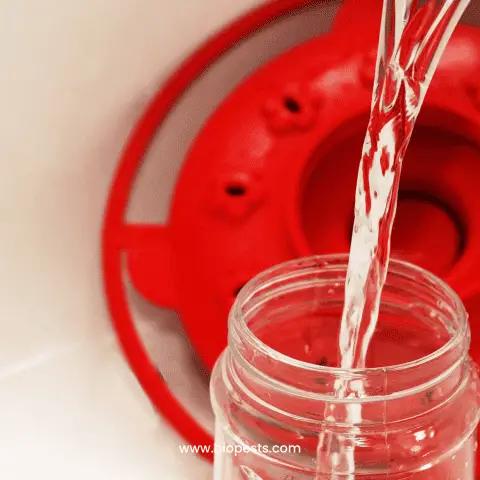
What to do If hummingbirds do not feed from the feeder
Sometimes, despite your best efforts, hummingbirds seem to avoid the feeder. If this is the case, have patience, and try to be persistent. Below are some of the reasons Hummingbirds may not be feeding from the feeder:
- Temperature Changes
- Unfamiliarity with the Feeder
- Feeder Placement. A solution could be to move the birdfeeder regularly to encourage exploration.
- The presence of predators or other wildlife around the Feeder
- The Nectar. Hummingbirds can be picky about their nectar and may only feed on the freshest nectar
- Also, try different types of nectar. Different species of hummingbirds have different preferences, so you may want to try changing the nectar solution’s flavors to see which works best.
- The cleanliness of the feeder.
Hummingbirds are a beautiful addition to any backyard, and they can be easily attracted with the right nectar feeder. Watching the birds flock and sip from the feeder is an amazing experience.
Don’t be discouraged if you find other birds or squirrels feeding on your hummingbird feeders- it’s part of the birding world! All you have to do is move them away from your yard and remember those preventive measures for next time.
So, get out there and start creating an inviting home for these stunning creatures – if you do all the above, you will enjoy seeing a nest in your yard just like the one I found!
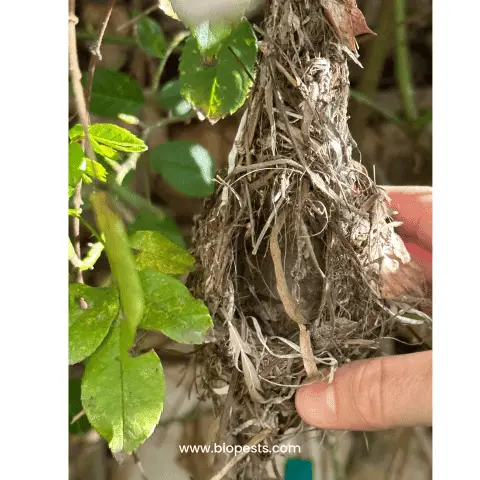
Some of the links above are affiliate links, meaning I will earn a commission if you click through and make a purchase at no additional cost to you.

